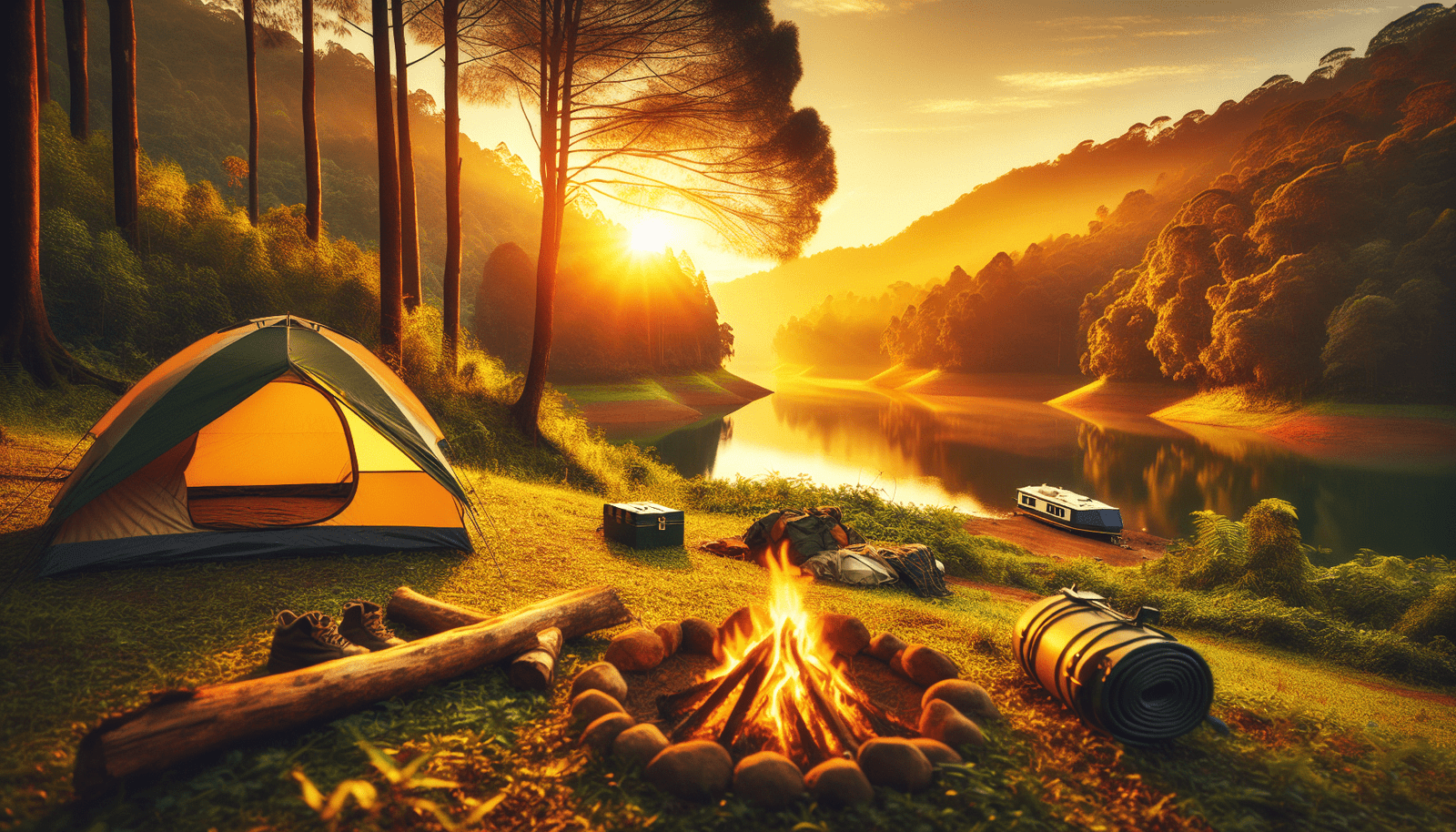Choosing the perfect camping spot can make all the difference in your outdoor adventure. In “How To Choose A Camping Location?” you’ll discover essential tips and tricks to find the ideal site that suits your needs and preferences. From considering the terrain and weather conditions to understanding the importance of nearby amenities and wildlife, this guide will equip you with the knowledge to select a location that ensures a memorable and enjoyable camping experience.
How To Choose A Camping Location?
Have you ever found yourself stumped by the seemingly endless options when trying to choose the perfect camping location? You’re not alone! Whether this is your first camping trip or you’re an experienced adventurer looking for new spots, picking the right location is crucial to ensure a memorable and enjoyable experience.

Why Is the Camping Location Important?
Your camping location can make or break your experience. It’s about more than just where you’ll pitch your tent. It determines your activities, your safety, and ultimately your enjoyment. A poor location might mean poor sleep, limited things to do, or even a dangerous setting. On the other hand, an ideal site can offer stunning views, ample activities, and a sense of peace.
Consider Your Interests
Before diving into specifics, think about what you personally enjoy:
Types of Camping
Are you more into wilderness camping, where you’ll be entirely remote and surrounded by nature? Or do you prefer a stay at a campground, with facilities and possibly some fellow campers nearby? Here’s a quick breakdown:
| Type | Description |
|---|---|
| Wilderness Camping | Remote, natural settings with little to no facilities. Ideal for experienced campers. |
| Campgrounds | Designated sites with facilities like restrooms, showers, and sometimes even Wi-Fi. Suitable for beginners or those who prefer some comforts. |
| Glamping | Combines camping with luxury. Think comfortable beds, sometimes even air conditioning. Great if you want to enjoy nature without roughing it too much. |
Understanding your camping style will help narrow down your options considerably.
Activities
Next up, think about what you like to do:
- Hiking: Do you love to explore and get your heart pumping with a challenging hike?
- Fishing: Maybe you prefer the peacefulness of fishing in a serene lake or river.
- Swimming: Warm weather and a refreshing swim go hand in hand.
- Wildlife Watching: If you’re an animal lover, you’ll want a spot known for its local fauna.
Different locations cater to different activities, so having an interest checklist can guide your choice.
Geographic Considerations
Distance
How far are you willing to travel? Consider both how long it will take to get there and how much gas you’ll need. A location hours away might be perfect for a long getaway, while a nearby spot could be ideal for a quick weekend trip.
Terrain
Do you prefer mountains, forests, beaches, or perhaps a desert? Each type of terrain comes with its own set of advantages and challenges:
| Terrain | Pros | Cons |
|---|---|---|
| Mountains | Scenic views, challenging hikes | Cold temperatures, potentially dangerous |
| Forests | Abundant wildlife, shaded areas | Insects, possibly muddy grounds |
| Beaches | Swimming opportunities, relaxing vibes | Crowds, limited shade |
| Deserts | Unique landscapes, dry climate | Extreme temperatures, lack of water sources |
Accessibility
Think about how accessible the location is. If you have a regular car, will you be able to reach a remote site that requires high clearance? Additionally, consider the following:
- Road Conditions: Are the roads paved or will you need a 4×4 vehicle?
- Parking: Is there enough space to park your vehicle conveniently?
- Public Transport: If you don’t own a vehicle, is there a way to reach the site via public transport?
Environmental Conditions
Weather
Always check the weather forecast before you go. Weather can significantly impact your trip, affecting activities and your overall comfort. Sites prone to sudden weather changes might require extra preparedness.
Seasonal Factors
Seasons play a big role in your camping experience:
| Season | Pros | Cons |
|---|---|---|
| Spring | Blooming flowers, pleasant temperatures | Allergies, unpredictable weather |
| Summer | Warm weather, long days | Crowds, insects |
| Fall | Colorful foliage, cooler temperatures | Shorter days, cold nights |
| Winter | Quiet, snow activities | Very cold, limited activities |
Wildlife
Understand the local wildlife to prepare adequately. While seeing animals can be part of the charm, some wildlife might pose threats. Research the animals in the area and learn the best practices to stay safe.

Amenities and Facilities
Basic Amenities
Your needs for amenities can vary based on your comfort level and experience. Here’s what to consider:
| Amenity | Consideration |
|---|---|
| Restrooms | Flush toilets vs. pit toilets, cleanliness, availability |
| Showers | Hot water, cleanliness, privacy |
| Water Sources | Availability of drinking water, filtration needs |
| Fire Pits/Grills | Availability for cooking, safety measures |
| Trash Disposal | Proximity to disposal sites, recycling options |
Special Facilities
Some campgrounds offer additional facilities that might make your stay more enjoyable:
- Wi-Fi: Useful for staying in touch or for those working remotely.
- Electric Hookups: Perfect if you have a camper or need to charge devices.
- Playgrounds: Great if you’re camping with kids.
- Laundry Facilities: Helpful for longer stays.
Safety Considerations
Hazard Assessment
Assess potential hazards such as:
- Flood Zones: Be aware of areas prone to sudden flooding.
- Fire Risks: Check fire bans and the availability of fire pits.
- Crime Rates: Look up the safety reputation of the area.
- Wildlife Threats: Know if there’s a risk of encountering dangerous animals.
Emergency Services
Identify the proximity and availability of emergency services:
- Medical Facilities: How far is the nearest hospital or urgent care center?
- Ranger Stations: Are there rangers or park officials available to assist in emergencies?
- Cell Service: Is there reliable cell phone coverage for emergency calls?
Permits and Regulations
Camping Permits
Some areas require permits for camping, especially in popular national parks or preserved lands. Permits often need to be acquired in advance and can have specific conditions.
Fishing and Hunting Licenses
If you plan on fishing or hunting, you’ll likely need appropriate licenses. These too should be acquired in advance, and rules can vary by location.
Fire and Safety Regulations
Know the fire regulations of the area. Fire bans are common in drought-prone regions, and violating these can lead to hefty fines and severe safety risks.
Leave No Trace Principles
Adhering to Leave No Trace principles is crucial for any camper. This includes:
- Pack Out All Trash: Leave your site cleaner than you found it.
- Minimize Campfire Impact: Use established fire rings and keep fires small.
- Respect Wildlife: Keep a safe distance and avoid feeding animals.
Group Size and Dynamics
Party Size
Think about the size of your camping group. Some locations have limits on the number of people per site, and others may offer group sites for larger parties.
Group Preferences
Different people have different needs and preferences:
- Families with Kids: Look for family-friendly sites with safe areas to play.
- Friends’ Getaway: Maybe you want a more remote spot where you can make some noise.
- Romantic Retreat: A secluded, scenic location could be ideal.
Meal Planning
Cooking for a group can be a fun communal activity but requires planning:
- Facilities: Do you have enough cooking equipment?
- Dietary Needs: Consider any special dietary restrictions within your group.
- Storage: Secure food storage options to protect from wildlife.
Budget Considerations
Site Fees
Different campgrounds charge different fees. Wilderness areas might be free but lack amenities, while developed campgrounds could charge anywhere from $10 to $50 per night.
Travel Costs
Factor in the cost of gas, tolls, or possibly air travel if you’re going far.
Gear and Supplies
Make sure to budget for the necessary camping gear if you don’t already own it. Costs can add up, especially for newcomers.
Hidden Costs
Consider additional costs like firewood, entry fees for certain activities, or special permits for fishing and hunting.
Special Situations
Pets
Not all camping locations are pet-friendly. Do your research:
- Pet Policies: Check if pets are allowed.
- Facilities: Look for dog-friendly trails or swimming areas.
- Safety: Ensure your pet will be safe from local wildlife and environmental hazards.
Disabilities
Accessibility can be crucial for campers with disabilities. Seek out locations that offer:
- Accessible Facilities: Restrooms, showers, and sometimes even trails.
- Proximity to Services: Shorter walks to amenities and parking areas.
- Special Permits: Some parks offer permits and passes for disabled visitors at reduced rates.
First-Time Campers
If it’s your first time:
- Choose a Developed Campground: Facilities and amenities can make the experience less daunting.
- Stay Close to Home: If things go wrong, it’s easier to pack up and leave.
- Trial Runs: Consider a backyard camping trip to get a feel for it.
Conclusion
Selecting the perfect camping location involves balancing your interests, comfort, and safety. By considering factors like distance, terrain, amenities, and safety risks, you can make an informed choice that suits your needs and ensures a memorable outing.
Ultimately, planning ahead and doing your research can save you from a host of potential issues, paving the way for a truly enjoyable camping experience. And there you have it! Now you’re all set to choose a camping location that meets your needs and boosts your enthusiasm for the great outdoors. Happy camping!
